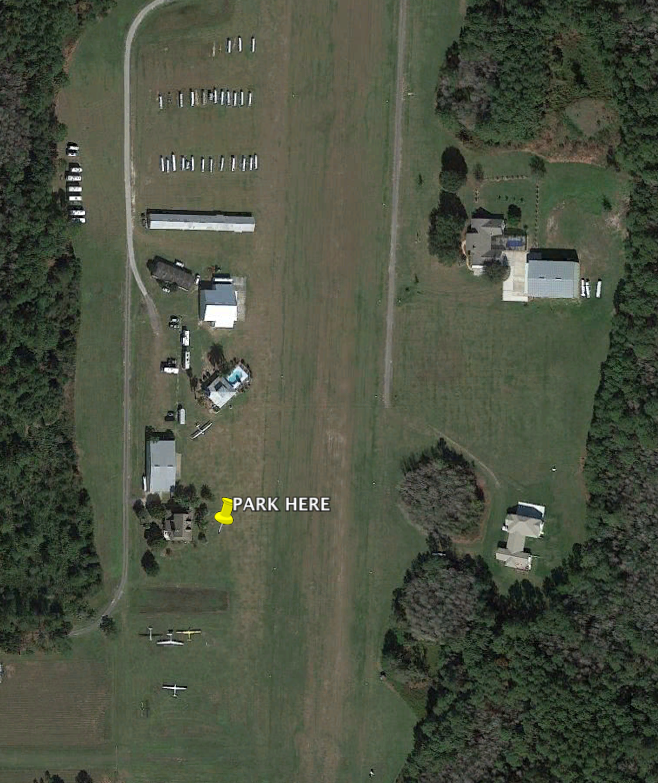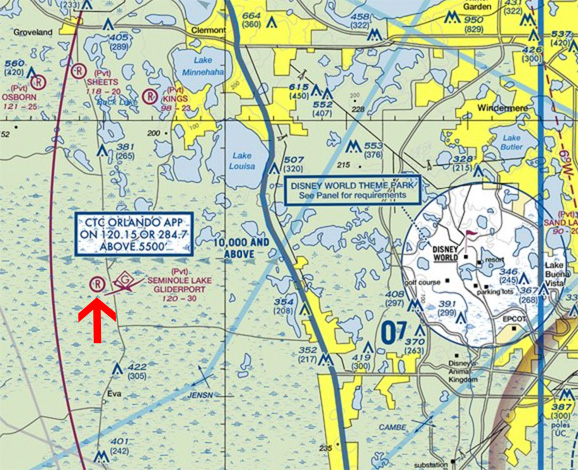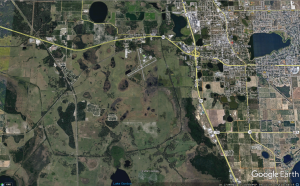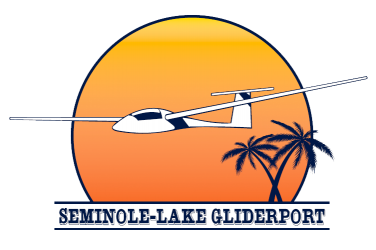Airfield info
Seminole-Lake Gliderport is a Commercial operation, but a Private airfield. Please call ahead for permission to fly in. All visiting aircraft should park in front of the 2-story house.

Runway 36:
*3,000 feet long by 200 feet wide
*Right Traffic Pattern
*Displaced Threshold 600 feet
Runway 18:
*3,000 feet long by 200 feet wide
*Left Traffic Pattern
*Displaced Threshold 300 feet
*Surface is turf
*WX ASOS at KZPH (20 nm SW): 118.975 (813) 780-0031
*Radio Frequency 123.300 mhz
*Traffic pattern on east side of airfield only
*28-24-21.0190N / 081-50-16.2790W
*28-24.350317N / 081-50.271317W
*28.4058386 / -81.8378553
*Airfield Identifier 6FL0
*Elevation 120 feet MSL
*Taxi west of runway

Field Rules
Field Elevation: 120 Feet
Unicom: 123.3
1. RUNWAY (18-36)
2. Left Hand Pattern- Runway 18, Right Hand Pattern- Runway 36
3. Initial Point 1200′ (East I.P.’s) Note: The I.P.’s to be pointed out by an SLG Instructor on the field checkout.
4. Join downwind leg at 1000 feet.
5. After landing, plan to roll the glider to a stop on the West side of the runway. Be cautious and roll very slow through the swale if you roll onto the taxiway. Get quickly out of the glider (make sure you don’t drop the tail on the Grob) and pull the glider further away from the runway, West of the tire markers so the taxiway remains clear at all times.
6. If there is a tow plane and glider ready to depart or if there is an incoming glider, try to clear the runway as soon as possible to avoid congestion on the runway and maintain good safety rules. The thresholds and runways are marked with auto tires painted white. The taxiway is the West side of the runway and should always be used to pull gliders down to the staging area.
7. Never land short on runway 36 when other traffic is lined up for takeoff on the East side of the runway. Remember the glider has to land and come to a stop past the threshold and be pulled off on the West side of the runway. NOTE: There is no room donw on the South end before the threshold to do that. The deep swales on the South end make it impossible to pull the glider off onto the taxiway before the threshold
GROUND HANDLING AND DEPARTURES:
1. All gliders are to be pulled down to the end of the runway using the West taxiway. No gliders are to be pulled down on the runway except for crossing and positioning for launch on the runway. The same rule applies for airplanes. No taxiing on the runway, nor is the run-up done on the runway. This is a Gliderport and courtesy has to be given to the glider operation so that it can be conducted with the utmost safety and efficiency.
2. When gliders are ready for launch, position glider at point of departure facing the direction of take-off on the far side of the runway. Towplane pilot will taxi out immediately for hook-up. NOTE: Never pull glider onto the runway before you are ready to launch, and never start a pre-flight when glider is lined up on the runway.
3. Maximum downwind takeoff wind speed is 10 MPH. No downwind takeoffs on Runway 18. Also extreme caution must be taken when glider operations use downwind takeoff on Runway 36 and land on Runway 18.
4. All aircraft departing must make climbing turns to the East.
GENERAL RULES AROUND THE GLIDERPORT
1. No thermaling permitted below 1200 feet within the boundaries of the traffic pattern. Thermaling at or below 1200 feet will be fined $35.00
2. Transition the field at above 1500′, do not get below 1500′ on the West side of the runway.
3. No high speed pass will be executed by gliders or airplanes.
4. The Gliderport is open for airplanes to land at their own risk with the intention of joining us for a day of soaring. Airplanes are to call up on Frequency 123.3 with their intention. No touch and goes are allowed during glider activity. If you’re using our runway for your touch and go practice, we’ll charge $5 for each pattern.
5. Be cautious of the Military route 4 miles West of the field. This is most frequently used during weekdays and they travel from the North to the South between 400′ and 3000′.
6. NOTE: Due to the 30 N M Mode C Transponder requirement around the Orlando area our tow-planes are limited to 5000′ MSL tows.
7. WARNING: Any pilot making a gear-up landing or an off-field landing, without prior x-country approval will be charged a minimum $300 fine, plus damages. Any pilot breaking a canopy due to improper handling or negligence will be held totally responsible for the damages and any pilot damaging a glider from plain stupidity will be fully responsible for the damages.
8. NOTE: There is absolutely NO aerobatics allowed in Seminole-Lake Gliderport’s gliders.
9. Any pilot leaving a canopy open unattended will be fined $50.00
10. All students and pilots that rent one of our gliders MUST provide our staff copy of renter’s insurance for minimum $40,000 in hull damage.
NOTE: Only tow pilots and instructors certified and insured by Seminole-Lake Gliderport are allowed to tow and instruct at 6FL0. No other pilots are allowed to tow and instruct in their tow planes or gliders.
We hope you enjoy soaring with us. Let’s work together to make this a safe and pleasurable soaring site.
Thank you.
IMPORTANT NOTE FOR PRIVATE SHIPS
Lake Wales Parachuting Activity
There has been a dramatic increase in parachuting activity at Lake Wales airport. There is a NOTAM that covers this activity everyday from 7am to 7pm. To deconflict us from jumpers we are asking pilots flying cross country to follow these quick procedures:
- Prior to transitioning the airspace within 5 miles of the Lake Wales airport, contact Miami Center on 134.55 or 127.2 and ask if there is jumping activity at Lake Wales. Their jump aircraft will be on this frequency also.
- Ask Miami Center for location of jump aircraft if it’s airborne.
- Return to your cross-country frequency and announce if there is jumping in progress.
- If possible, stay to the east of Hwy-27 and avoid overflying the Lake Wales airport.
Let’s be good neighbors and share the airspace wisely. You certainly would not want to run into a parachutist on your cross-country.

Would you like to fly at our Glideport?
Schedule a flight